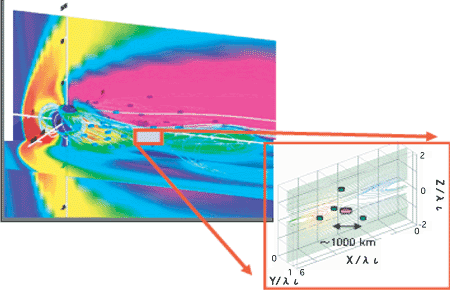|
Toward next-generation observation
Based on the discussion above, what form should the next-generation
observation program take? First, while keenly observing the key region, at the
same time we have to understand development as a whole. Also, we need to focus
on the electron scale in key-region observation. We believe that starting the
SCOPE program along with the NASA's MagCon program (Fig. 3) will satisfy these
requirements. The MagCom program will scatter tens of small satellites in the
magnetosphere and investigate the whole MHD-like figure, though each satellite
can only make simple observation. It will
perform more systematically what the ISTP attempted. The program is well-defined
regarding a comprehension of what happens in the focal and whole region in magnetospheric
physics, because the satellite interval is set at two to three times the earth's
radius. It closely covers the magnetosphere, which entends from ten to thirty
times the earthÉÜs radius in
geocentric distance.In the context of "cross-scale coupling," however,
we need to observe the key region that triggers the phenomena and, by resolving
the electron scale in the magnetic reconnection region, to understand not only
what occurs,
but also what mechanism triggers the phenomena based on actual evidence. Therefore,
along with the MagCon, which will study the whole, if we run the five-satellite
formation program SCOPE, we will be able to (1) investigate the spatial structure
of the key region at ion-scale level, (2) take measurements of the plasma particles
in high time resolution, (3) observe
the plasma wave at its center, and finally (4) fully resolve the dynamics of the
key region at electron-scales.

Figure 3. MagCom Program (left) and SCOPE Program (right)
We expect that joint observation by MagCon and SCOPE will be implemented ten years
later. We have many items to develop by that time. We aim at the "perfect
observation of the key region", and at overcoming the difficulties before
us. Needless to say, there are many open issues because this will be the first
Japanese formation flight. We have started discussing not only the design and
basic development of observation instruments, but also satellite structure to
install the instruments in optimum condition. Ten years may seem a long way off.
I believe we can enrich the next-generation program only by keeping an awareness
of "cross-scale coupling." While current activities, such as data analysis
of on-going projects and
large-scale numerical simulations, do not appear to be directly related to the
SCOPE program, as long as the efforts are devoted to the real understanding of
the plasma universe, they will eventually contribute to the SCOPE program. It
seems that our approach to real understanding will only become possible in a roundabout
way with the formidable high time
resolution (10msec) observation. Considering that we are investigating space plasma,
however, a wonder world in which common sense does not apply, believe that "slow
but sure wins the race" is the perfect strategy..
(Masaki Fujimoto)
|
![]()






